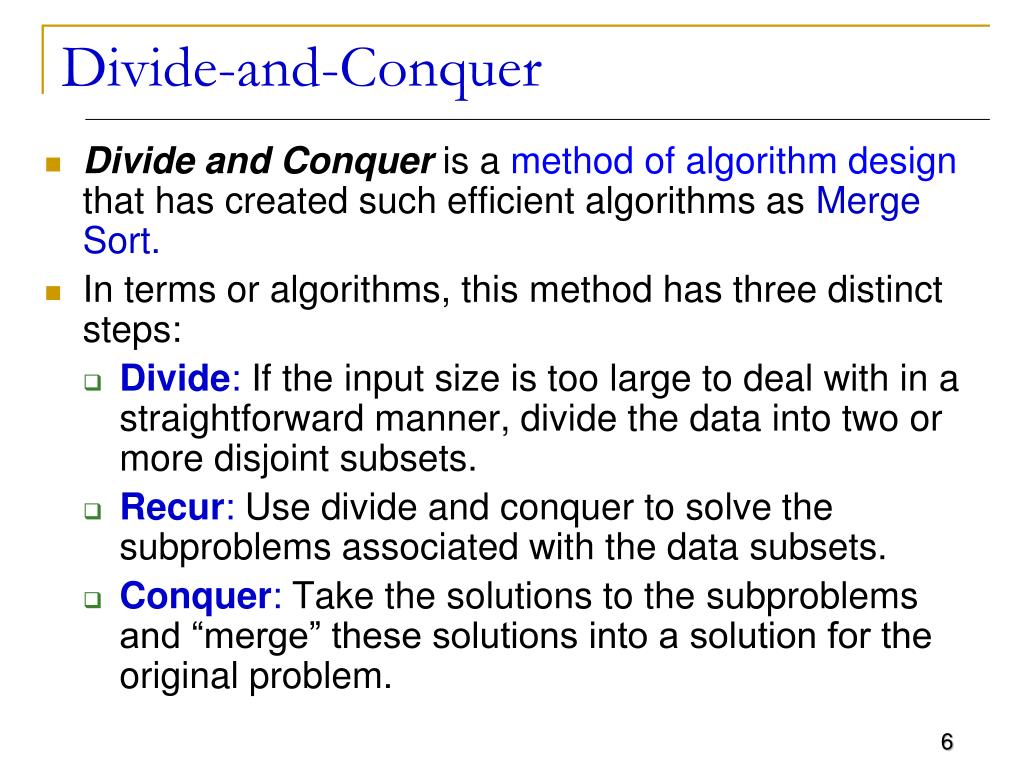

The elements less than or equal to the pivot are placed in the "less" group, while the elements greater than the pivot are placed in the "greater" group. The pivot element is chosen as the first element of the input array. In this implementation, the quick_sort function is called recursively to sort the "less" and "greater" groups of elements. Here's a Python implementation of the quick sort algorithm:ĭef quick_sort ( arr ) : if len ( arr ) pivot ] return quick_sort ( less ) + + quick_sort ( greater )
#DIVIDE AND CONQUER SORTING AND SEARCHING CODE#
Now, let's dive deeper into the quick sort implementation with code examples.
Combine the sorted groups and the pivot element to create the final sorted array. Partition the array into two groups – elements less than the pivot and elements greater than the pivot. If the array has less than two elements, it is already sorted. Here's a high-level overview of the quick sort algorithm: Quick sort has an average-case time complexity of O(n log n), but its worst-case time complexity is O(n^2), making it less optimal than merge sort for certain datasets. The pivot element is then placed in its correct position, and the algorithm is recursively applied tothe two groups. It works by selecting a "pivot" element from the array and partitioning the other elements into two groups – those less than the pivot and those greater than the pivot. Quick sort is another sorting algorithm that follows the Divide and Conquer approach. Otherwise, the element from the right half is appended. If an element in the left half is smaller than or equal to an element in the right half, the element from the left half is appended to the result array. The merge function combines the two sorted halves by iterating through their elements and comparing them. 
In this implementation, the merge_sort function is called recursively to sort the left and right halves of the input array. append ( right ) right_index += 1 result += left result += right return result append ( left ) left_index += 1 else : result. Mid = len ( arr ) // 2 left_half = arr right_half = arr left_half = merge_sort ( left_half ) right_half = merge_sort ( right_half ) return merge ( left_half, right_half ) def merge ( left, right ) : result = left_index = 0 right_index = 0 while left_index < len ( left ) and right_index < len ( right ) : if left <= right : result. Here's a Python implementation of the merge sort algorithm:ĭef merge_sort ( arr ) : if len ( arr ) <= 1 : return arr Now, let's dive deeper into the merge sort implementation with code examples. Merge the two sorted halves to create the final sorted array.If the array has only one element, it is already sorted.Here's a high-level overview of the merge sort algorithm: Merge sort is known for its stability and O(n log n) time complexity, making it an efficient sorting algorithm for large datasets.

It sorts an array by dividing it into two halves, recursively sorting each half, and then merging the two sorted halves to produce the final sorted array. Merge sort is a sorting algorithm that follows the Divide and Conquer approach.
Combine: Merge the solutions of the subproblems to get the final solution. Conquer: Solve the subproblems recursively. Divide: Split the problem into smaller subproblems. The Divide and Conquer strategy typically consists of three steps: The Divide and Conquer approach can be applied to a wide range of problems, and it is particularly useful when dealing with recursive problems. The main idea behind this approach is to break a problem into smaller subproblems, solve these subproblems independently, and then combine their solutions to form the solution to the original problem. Divide and Conquer Approachĭivide and Conquer is a fundamental algorithm design paradigm in computer science. By the end of this blog post, you will have a strong understanding of the Divide and Conquer technique and its usefulness in designing efficient algorithms. We will explore the inner workings of both merge sort and quick sort, discussing their implementation and performance characteristics. The Divide and Conquer technique is a powerful problem-solving strategy that allows us to solve complex problems by breaking them down into smaller subproblems. In this blog post, we will delve into the concept of the Divide and Conquer approach in computer science, with a focus on its application in two popular sorting algorithms: merge sort and quick sort.







 0 kommentar(er)
0 kommentar(er)
